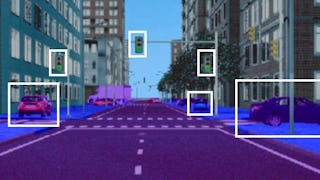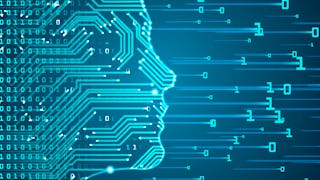Unlock the power of deep learning to transform visual data into actionable insights. This hands-on course guides you through the foundational and advanced techniques that drive modern computer vision applications—from image classification to generative modeling.

Entdecken Sie neue Fähigkeiten mit 30% Rabatt auf Kurse von Branchenexperten. Jetzt sparen.


Deep Learning for Computer Vision
Dieser Kurs ist Teil von Spezialisierung für Computer Vision

Dozent: Tom Yeh
Bei  enthalten
enthalten
Empfohlene Erfahrung
Was Sie lernen werden
Improve model performance and training stability using multilayer perceptrons (MLPs) and applying normalization techniques.
Implement autoencoders for unsupervised feature learning and design Generative Adversarial Networks (GANs) to generate synthetic images.
Train convolutional neural networks (CNNs) for image classification tasks, understanding how layers extract spatial features from visual data.
Apply advanced architectures like ResNet for deep image recognition and U-Net for image segmentation.
Kompetenzen, die Sie erwerben
- Kategorie: Unsupervised Learning
- Kategorie: Applied Machine Learning
- Kategorie: Computational Logic
- Kategorie: Artificial Intelligence
Wichtige Details

Zu Ihrem LinkedIn-Profil hinzufügen
August 2025
21 Aufgaben
Erfahren Sie, wie Mitarbeiter führender Unternehmen gefragte Kompetenzen erwerben.

Erweitern Sie Ihre Fachkenntnisse
- Lernen Sie neue Konzepte von Branchenexperten
- Gewinnen Sie ein Grundverständnis bestimmter Themen oder Tools
- Erwerben Sie berufsrelevante Kompetenzen durch praktische Projekte
- Erwerben Sie ein Berufszertifikat zur Vorlage

In diesem Kurs gibt es 4 Module
Welcome to Deep Learning for Computer Vision, the second course in the Computer Vision specialization. In this first module, you'll be introduced to the principles behind neural networks and their use in visual recognition tasks. You'll begin by learning the basic building blocks—neurons, weights, biases—and progress toward constructing simple multi-layer perceptrons. Then, you'll discover key activation concepts like batch processing and graph-matrix conversions. Finally, you will visualize neural networks with an emphasis on classification tasks.
Das ist alles enthalten
19 Videos8 Lektüren6 Aufgaben
In this module, you’ll explore two powerful architectures in deep learning: autoencoders and generative adversarial networks (GANs). You’ll begin by learning how autoencoders compress and reconstruct data using encoder-decoder structures, and how reconstruction loss is minimized through backpropagation and gradient descent. You’ll then examine the role of loss functions and optimization techniques in training these models. In the second half of the module, you’ll dive into GANs, where a generator and discriminator compete to produce realistic synthetic data. You’ll study how adversarial training works, how binary cross-entropy loss is applied, and how GANs are used to model complex data distributions. By the end of this module, you’ll be able to implement and evaluate both autoencoders and GANs for representation learning and data generation.
Das ist alles enthalten
13 Videos2 Lektüren5 Aufgaben
In this module, you’ll learn how convolutional neural networks extract features from images and perform classification. You’ll begin by building a tiny CNN by hand and in Excel, exploring convolution, max-pooling, and fully connected layers. Then, you’ll scale up to larger CNN architectures and examine how they process data through multiple convolution and pooling stages. You’ll also study how categorical cross-entropy loss and gradients are computed for training. Finally, you’ll walk through backpropagation across all CNN layers to understand how learning occurs.
Das ist alles enthalten
16 Videos1 Lektüre5 Aufgaben
In this module, you’ll explore two influential deep learning architectures: ResNet and U-Net. You’ll begin by learning how ResNet uses skip connections and residual learning to enable the training of very deep networks, addressing challenges like vanishing and exploding gradients. You’ll examine how residual blocks preserve information and support higher-order logic across layers. Then, you’ll shift to U-Net, a powerful architecture for image segmentation, and study its encoder-decoder structure, skip connections, and upsampling techniques like transposed convolution. By the end of this module, you’ll understand how both architectures enhance learning efficiency and performance in complex vision tasks.
Das ist alles enthalten
17 Videos2 Lektüren5 Aufgaben
Erwerben Sie ein Karrierezertifikat.
Fügen Sie dieses Zeugnis Ihrem LinkedIn-Profil, Lebenslauf oder CV hinzu. Teilen Sie sie in Social Media und in Ihrer Leistungsbeurteilung.
Dozent

Mehr von Algorithms entdecken
 Status: Vorschau
Status: VorschauUniversity of Colorado Boulder
 Status: Kostenloser Testzeitraum
Status: Kostenloser TestzeitraumMathWorks
 Status: Kostenloser Testzeitraum
Status: Kostenloser TestzeitraumUniversity of Colorado Boulder
 Status: Kostenloser Testzeitraum
Status: Kostenloser Testzeitraum
Warum entscheiden sich Menschen für Coursera für ihre Karriere?





Neue Karrieremöglichkeiten mit Coursera Plus
Unbegrenzter Zugang zu 10,000+ Weltklasse-Kursen, praktischen Projekten und berufsqualifizierenden Zertifikatsprogrammen - alles in Ihrem Abonnement enthalten
Bringen Sie Ihre Karriere mit einem Online-Abschluss voran.
Erwerben Sie einen Abschluss von erstklassigen Universitäten – 100 % online
Schließen Sie sich mehr als 3.400 Unternehmen in aller Welt an, die sich für Coursera for Business entschieden haben.
Schulen Sie Ihre Mitarbeiter*innen, um sich in der digitalen Wirtschaft zu behaupten.
Häufig gestellte Fragen
To access the course materials, assignments and to earn a Certificate, you will need to purchase the Certificate experience when you enroll in a course. You can try a Free Trial instead, or apply for Financial Aid. The course may offer 'Full Course, No Certificate' instead. This option lets you see all course materials, submit required assessments, and get a final grade. This also means that you will not be able to purchase a Certificate experience.
When you enroll in the course, you get access to all of the courses in the Specialization, and you earn a certificate when you complete the work. Your electronic Certificate will be added to your Accomplishments page - from there, you can print your Certificate or add it to your LinkedIn profile.
If you subscribed, you get a 7-day free trial during which you can cancel at no penalty. After that, we don’t give refunds, but you can cancel your subscription at any time. See our full refund policy.
Weitere Fragen
Finanzielle Unterstützung verfügbar,

